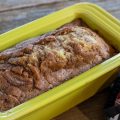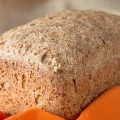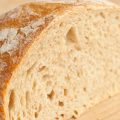Chocolate sourdough bread might not be your first introduction to sourdough – in fact, it might seem like an unlikely sourdough choice. But in my opinion, how to make Chocolate sourdough bread is a must skill for any bread lover. This recipe we have today creates a loaf that’s visually stunning and boasts a rich, complex taste. And if you’re a chocolate lover like me, this is an excellent recipe to add to your baker’s arsenal!
![How To Make Chocolate Sourdough Bread - A Sweet Twist On The Classic 137 How to make chocolate sourdough bread [step by step guide]](https://www.mydailysourdoughbread.com/wp-content/uploads/2024/05/How-to-Make-Chocolate-Sourdough-Bread-6-840x473.jpg)
Table of Contents
- Ingredients
- Preparation of Sourdough Starter
- Combining Ingredients
- First Fermentation
- Shaping the Dough
- Second Fermentation (Proofing)
- Baking
- Troubleshooting Tips
- Serving and Pairing Ideas
- Sourdough + Chocolate = Unexpectedly GOOD Combo
- How to Make Chocolate Sourdough Bread: FAQs
Ingredients
Here’s what you’ll need for this recipe:
- Bread flour (3 cups)
- All-purpose flour (1 cup)
- Water (1 1/2 cups)
- Sourdough starter (1/2 cup)
- Unsweetened cocoa powder (1/2 cup)
- Salt (1 tsp)
- Sugar (2 tbsp)
- Ground pistachios (optional)
- Chocolate chips (optional) – I didn’t use them for my own recipe, but these are a typical (and delicious) addition!
Preparation of Sourdough Starter
To begin, you’ll need just a few simple ingredients: flour, water, and a little patience. Mix equal parts of flour and water in a clean glass or ceramic container, stirring until you have a smooth, lump-free batter. Cover the container loosely with a lid or plastic wrap and let it sit at room temperature for 24 hours.
Step-by-Step Starter Preparation
After the initial 24 hours, it’s time to start feeding your sourdough starter. Each day, discard about half of the starter mixture and replace it with equal parts of fresh flour and water. Stir well, cover, and let it sit again at room temperature. Repeat this process daily for about 5-7 days, or until your starter doubles in size within 4-8 hours after feeding and has a pleasantly sour aroma.
Fermentation and Active Starter
As you continue feeding your starter, you’ll notice bubbles forming on the surface – a sign that wild yeast and beneficial bacteria are working their magic. This fermentation process is what gives sourdough bread its distinctive tangy flavor and chewy texture. Once your starter is active and bubbly, it’s ready to be used in your chocolate sourdough bread recipe.
Combining Ingredients
In a large mixing bowl, whisk together the bread flour, all-purpose flour, cocoa powder, salt, and sugar until well combined. Make a well in the center of the dry ingredients and pour in the water and active sourdough starter. Using a wooden spoon or your hands, mix the ingredients until a shaggy dough forms. At this point, don’t worry about kneading the dough; just ensure that all the dry ingredients are hydrated.
Incorporating Add-ins
Once you have a cohesive dough, it’s time to add whatever you want. Gently fold them into the dough, distributing them evenly throughout.
Achieving the Perfect Dough Consistency
Pay attention to the consistency of the dough. The ideal chocolate sourdough dough should be slightly sticky but still manageable. If the dough feels too dry, add water, one tablespoon at a time, until you reach the desired consistency. Conversely, if the dough is overly sticky, add a bit more flour, a tablespoon at a time, until it becomes easier to handle.
First Fermentation
Time to let the dough rest and ferment.
Bulk Fermentation
Place the dough in a lightly oiled bowl, cover it with a clean, damp kitchen towel or plastic wrap, and let it undergo bulk fermentation at room temperature for about 4-6 hours. During this time, the dough will rise and develop its characteristic sourdough tang. To ensure even fermentation, gently fold the dough every 30-60 minutes, bringing the edges into the center and rotating the bowl a quarter turn each time.
Shaping and Final Proofing
Once the dough has doubled in size during bulk fermentation, it’s time to shape it. Gently transfer the dough onto a lightly floured surface and fold it into your desired shape, such as a boule or batard. Place the shaped dough into a well-floured proofing basket, seam-side up. Cover the basket with a clean, damp kitchen towel and let the dough proof at room temperature for another 1-2 hours, or until it has risen significantly and feels light and airy to the touch.
Tips for Optimal Fermentation
To ensure the best results during fermentation, keep an eye on the temperature and humidity of your kitchen. Sourdough thrives in warm, slightly humid environments. If your kitchen is too cool, you can create a makeshift proofing box by placing the dough in a turned-off oven with a bowl of hot water beneath it. This will provide a warm, moist environment that encourages fermentation.
Shaping the Dough
Proofing Basket
Prepare your proofing basket, also known as a banneton.
Line the basket with a clean, lint-free baker’s linen or a thin cotton towel dusted with flour. This will prevent the dough from sticking and create a beautiful pattern on the surface of your loaf.
Shaping Techniques for Chocolate Sourdough
Gently transfer it to a lightly floured surface. Fold the dough in on itself a few times to create a tight, smooth surface. For a classic round loaf, cup your hands around the dough and gently rotate it, using the tension between your hands and the work surface to create a tight ball. For an oval-shaped loaf, roll the dough on the surface, tapering the ends slightly.
Scoring the Dough
Once your dough is shaped and placed in the prepared proofing basket, it’s time to score the surface. Using a sharp blade or a razor, make a few deliberate cuts on the surface of the dough. This not only creates an attractive pattern but also allows the bread to expand properly during baking. Experiment with different scoring patterns, such as a simple cross, a wheat stalk design, or even a decorative leaf pattern that complements the rich chocolate hue of the bread.
Final Proofing
After shaping and scoring your chocolate sourdough dough, cover the proofing basket with a clean, damp kitchen towel or plastic wrap. Let the dough proof at room temperature for about 45 minutes to an hour, or until it has puffed up and feels light and airy to the touch. Your dough is now ready for baking and will soon transform into a stunning, flavorful loaf of chocolate sourdough bread.
- High Quality Banneton Bread Proofing Basket Kit: The high-quality banneton basket is hand-woven from natural Indonesian rattan, with smooth surfaces free of splinters and foul smell. The natural hygroscopic properties of rattan help to absorb excess moisture from the surface of the dough, resulting in a better shell texture. The sourdough proofing basket direct contact with food is completely safe.
Prices pulled from the Amazon Product Advertising API on:
Product prices and availability are accurate as of the date/time indicated and are subject to change. Any price and availability information displayed on [relevant Amazon Site(s), as applicable] at the time of purchase will apply to the purchase of this product.
Second Fermentation (Proofing)
Ideal Proofing Conditions for Chocolate Sourdough
Once you’ve shaped your chocolate sourdough dough, it’s time for the final rise, also known as proofing.
To achieve the best results, find a warm, draft-free spot in your kitchen. Aim for a temperature between 75-80°F (24-27°C) for optimal proofing conditions. If your kitchen is on the cooler side, you can create a makeshift proofing box by placing the dough in a turned-off oven with a bowl of hot water beneath it.
Proofing Duration and Signs of Readiness
The proofing time for chocolate sourdough can vary depending on factors such as the temperature and the strength of your starter. Typically, this final rise will take anywhere from 1-3 hours. Keep an eye on your dough during this time. You’ll know it’s ready to bake when it has nearly doubled in size and feels light and airy to the touch. Gently poke the dough with your finger; if the indentation slowly springs back, it’s ready for the oven.
Using a Proofing Cloth for Better Results
To prevent your dough from sticking and to create a beautiful pattern on the surface of your loaf, consider using a proofing cloth, also known as a baker’s couche. This breathable fabric, often made from linen or cotton, helps to wick away moisture and maintain the shape of your dough during proofing.
Dust the cloth generously with flour before placing your shaped dough on it, seam-side up. Fold the edges of the cloth over the dough to create a supportive cocoon for the final rise.
- AUTHENTIC 100% FLAX LINEN: Top quality French import, extra large couche fabric, 35x26 inches, is of premium professional quality, made from 100% natural flax linen, untreated and unbleached.
Prices pulled from the Amazon Product Advertising API on:
Product prices and availability are accurate as of the date/time indicated and are subject to change. Any price and availability information displayed on [relevant Amazon Site(s), as applicable] at the time of purchase will apply to the purchase of this product.
Baking
Preheating the Oven
Before baking your chocolate sourdough bread, preheat your oven to 450°F (230°C). If you have a baking stone, place it in the oven during preheating to ensure even heat distribution. If you don’t have a baking stone, a Dutch oven or a heavy baking sheet can also work well. Allow your oven to preheat for at least 30 minutes to ensure it reaches the desired temperature.
Creating Steam for a Crispy Crust
To achieve a crispy, golden-brown crust on your chocolate sourdough bread, it’s essential to create steam in the oven. You can do this by placing a shallow metal pan on the bottom rack of your oven during preheating. Just before placing your bread in the oven, carefully pour a cup of hot water into the pan, quickly closing the oven door to trap the steam inside.
Baking Duration and Temperature
Bake your chocolate sourdough bread at 450°F (230°C) for about 20 minutes. Then, reduce the temperature to 400°F (200°C) and continue baking for another 25-30 minutes, or until the bread develops a deep, rich color and sounds hollow when tapped on the bottom. Keep an eye on your bread during baking, as the chocolate may cause it to brown faster than regular sourdough.
Checking for Doneness
To ensure your chocolate sourdough bread is fully baked, use an instant-read thermometer to check its internal temperature. The bread is ready when it reaches an internal temperature of 200-205°F (93-96°C). If you don’t have a thermometer, carefully remove the bread from the oven and tap the bottom – it should sound hollow and feel light and crisp.
Cooling and Slicing
Once your chocolate sourdough bread is done baking, transfer it to a wire rack and let it cool completely before slicing. This cooling process allows the crumb structure to set and develops the bread’s final texture. Resist the temptation to slice the bread while it’s still warm, as this can cause the inside to appear gummy and underbaked. Once cooled, slice your bread with a sharp, serrated knife and enjoy the heavenly aroma and flavor of your homemade chocolate sourdough bread!
![How To Make Chocolate Sourdough Bread - A Sweet Twist On The Classic 140 How to make chocolate sourdough bread [step by step guide]](https://www.mydailysourdoughbread.com/wp-content/uploads/2024/05/How-to-Make-Chocolate-Sourdough-Bread-7-473x840.jpg)
Troubleshooting Tips
Overproofing
Overproofed dough will result in a flat, dense loaf with a lackluster flavor.
To avoid this, keep a close eye on your dough during the final rise. It should increase in size by about 50% and feel light and airy to the touch. If you poke it gently with your finger, the indentation should slowly spring back.
Undermixing
On the flip side, not mixing your ingredients thoroughly enough can also lead to subpar results. Make sure to mix your dough until it comes together in a shaggy, cohesive mass with no dry flour spots remaining. This will ensure the chocolate and starter are evenly distributed for optimal flavor and texture.
Opening the Oven Too Early
It can be tempting to peek at your bread while it’s baking, but resist the urge! Opening the oven door too soon will cause the temperature to drop rapidly, which can deflate your loaf.
Wait until at least the last 5-10 minutes of baking before quickly checking on your bread’s progress.
Serving and Pairing Ideas
- Chocolate sourdough bread is a yummy way to start your day. Toast a slice and spread on some butter or nut butter. It tastes great with a hot cup of coffee or tea. For an extra special treat, add some sliced bananas and a little honey on top.
- Use chocolate sourdough bread to make your grilled cheese sandwiches even better. HEAR ME OUT! The slight tanginess of the sourdough goes well with the richness of the chocolate, making a sandwich that tastes like nothing else. Try different cheeses, like brie with fig jam or sharp cheddar with crispy bacon.
- When you have friends over, let your chocolate sourdough bread steal the show on your snack platter. Cut the loaf into thin slices and put them next to meats, cheeses, fruits, and spreads. The bread’s unique flavors will make the whole platter taste even better and impress your guests.
- Chocolate sourdough bread is perfect for dessert pairings. Serve a warm slice with a scoop of vanilla ice cream or some fresh whipped cream. For a fancier dessert, use the bread to make a rich chocolate bread pudding or a grown-up version of s’mores, with toasted marshmallows and dark chocolate squares.
![How To Make Chocolate Sourdough Bread - A Sweet Twist On The Classic 141 How to make chocolate sourdough bread [step by step guide]](https://www.mydailysourdoughbread.com/wp-content/uploads/2024/05/How-to-Make-Chocolate-Sourdough-Bread-5-840x473.jpg)
Sourdough + Chocolate = Unexpectedly GOOD Combo
Today’s recipe combines the art of sourdough fermentation with the irresistible flavor of chocolate. Serve this versatile bread as toast, or as a decadent dessert!
How to Make Chocolate Sourdough Bread: FAQs
Does cocoa powder affect yeast?
Cocoa powder can affect yeast activity in bread dough. The acidity and antioxidants in cocoa may slow down yeast growth, leading to longer proofing times. However, using a small amount of cocoa powder (up to 10% of the flour weight) shouldn’t significantly impact the yeast. Adjust rising times as needed and consider increasing the yeast slightly when adding cocoa powder to your dough.
Is it worth it to make your own sourdough bread?
Making your own sourdough bread can be rewarding and cost-effective. It allows you to control the ingredients, customize flavors, and enjoy fresher bread. Homemade sourdough often has better texture and taste than store-bought. However, it does require time, patience, and practice to master the technique. If you enjoy baking and appreciate artisanal bread, making your own sourdough can be a satisfying and worthwhile hobby.
How to maintain a chocolate sourdough starter?
To maintain a chocolate sourdough starter, feed it equal parts flour, water, and cocoa powder. The feeding ratio can be 1:1:1 or 1:2:2, depending on the desired consistency. Feed your starter daily if kept at room temperature, or weekly if refrigerated. Ensure your starter doubles in size after each feeding before using it in recipes. Adjust the feeding schedule and ratios as needed.
Is it cheaper to bake your own sourdough bread?
Baking your own sourdough bread can be more cost-effective than buying artisanal sourdough from bakeries. The ingredients (flour, water, salt) are inexpensive, and you can make multiple loaves from one batch of starter. However, homemade bread may not be cheaper than mass-produced supermarket bread. Additionally, consider the cost of equipment, energy, and your time when determining if baking your own sourdough is more economical.
![How To Make Chocolate Sourdough Bread - A Sweet Twist On The Classic 142 How to make chocolate sourdough bread [step by step guide]](https://www.mydailysourdoughbread.com/wp-content/uploads/2024/05/How-to-Make-Chocolate-Sourdough-Bread-3-768x432.jpg)
Chocolate Sourdough Bread
Enjoy your homemade Chocolate Sourdough Bread!
- Yield: 1 loaf 1x
Ingredients
- 3 cups Bread Flour
- 1 cup All-Purpose Flour
- 1 1/2 cups Water
- 1/2 cup Sourdough Starter
- 1/2 cup Unsweetened Cocoa Powder
- 1 tsp Salt
- 2 tbsp Sugar
Optional
- Ground Pistachios
- Chocolate Chips
Instructions
Preparation of Sourdough Starter
- Combine equal parts of flour and water in a clean glass or ceramic container until smooth.
- Cover loosely and let sit at room temperature for 24 hours.
Step-by-Step Starter Preparation
- Daily, discard half the starter and replenish with fresh flour and water. Stir well.
- Continue for 5-7 days until the starter doubles in size and develops a sour aroma.
- Watch for bubbles on the surface, indicating active fermentation.
Combining Ingredients
- In a large bowl, whisk bread flour, all-purpose flour, cocoa powder, salt, and sugar.
- Make a well and add water and active starter. Mix to form a shaggy dough.
- Fold in optional ingredients if using.
- Adjust with extra water or flour to achieve a slightly sticky, manageable dough.
First Fermentation (Bulk Fermentation)
- Place dough in a lightly oiled bowl. Cover and let ferment at room temperature for 4-6 hours, folding dough occasionally.
Shaping and Final Proofing
- Shape the dough on a floured surface into a boule or batard.
- Place in a floured proofing basket, cover, and let rise until light and airy, about 1-2 hours.
Baking
- Preheat oven to 450°F (230°C). Place a baking stone or heavy baking sheet inside.
- Create steam by adding hot water to a shallow pan in the oven.
- Bake at 450°F for 20 minutes, then reduce to 400°F and bake for another 25-30 minutes.
- Bread is done when internal temperature reaches 200-205°F or sounds hollow when tapped.
Notes
- Allow bread to cool completely on a wire rack before slicing to set the crumb structure.
- Maintain a warm, slightly humid environment for optimal sourdough fermentation.
- Use a proofing cloth dusted with flour to handle and shape the dough without sticking.





![Soft Sourdough Bread [Easy Recipe + Tips] 145 Soft sourdough bread [easy recipe]](https://www.mydailysourdoughbread.com/wp-content/uploads/2024/02/Soft-Sourdough-Bread-120x120.jpg)


